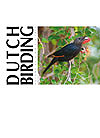Dutch Birding jaargang 33 nummer 1, 2011
VoorpaginaTristrams Spreeuw · Onychognathus tristramiiRené Pop |
|
Artikelen / papers | |
| 1 - 8 |
Variation and difference in song between Western Bonelli’s Warbler and Eastern Bonelli’s Warbler
Dick Groenendijk & Teus J C Luijendijk Variatie en verschil in zang tussen Bergfluiter en BalkanbergfluiterBergfluiter Phylloscopus bonelli (\'bonelli\') en Balkanbergfluiter P orientalis (\'orientalis\') lijken in morfologie zeer sterk op elkaar en in de praktijk worden beide soorten meestal gedetermineerd op basis van hun karakteristieke contactroep (\'de roep\'). Het blijkt echter dat de territoriumzang (\'de zang\') van beide soorten eveneens verschilt. Daarmee zijn zingende vogels in het voorjaar goed te determineren, zelfs als een exemplaar niet roept. In dit artikel wordt op basis van uitgebreide studie van opnames en sonagrammen van beide soorten beschreven in welke facetten hun zang verschilt. Belangrijk is om een opname van de zingende vogel te maken want alleen daarmee is een sluitende determinatie mogelijk. Dick Groenendijk, Elzenstraat 14, 4043 PB Opheusden, Netherlands |
| 9 - 21 |
Taimyr Gulls: evidence for Pacific winter range, with notes on morphology and breeding
Klaas van Dijk, Sergei Kharitonov, Holmer Vonk & Bart Ebbinge Taimyrmeeuwen: bewijzen voor Pacifisch overwinteringsgebied en gegevens over morfologie en broedenTaimyrmeeuwen Larus taimyrensis zijn grote witkoppige meeuwen die broeden op het Taimyrschiereiland in het uiterste noorden van Centraal-Siberië, Rusland (figuur 1). Het is niet goed bekend waar ze overwinteren. Oorzaken zijn een gebrek aan terugmeldingen en onzekerheid over herkenning buiten de broedgebieden. Daarom wordt een korte beschrijving gegeven van het uiterlijk, geïllustreerd met foto\'s uit het broedgebied, en wordt kort ingegaan op het voorkomen op Taimyr. Klaas van Dijk, WIWO, Vermeerstraat 48, 9718 SN Groningen, Netherlands |
| 22 - 30 |
Birding in Brazil: Alta Floresta region
Alexander C Lees |
WP reports | |
| 31 - 33 |
Late November 2010–mid-January 2011
Arnoud B van den Berg & Marcel Haas |
Artikelen / papers | |
| 34 - 37 |
Rotskruiper bij Maastricht in november-december 2010
Arnold W J Meijer Wallcreeper near Maastricht in November-December 2010On 22 November 2010, a Wall-creeper Tichodroma muraria was discovered at a quarry south of Maastricht, the Netherlands. The bird was observed daily until 11 December by a steady stream of birders (c 1000 in total). After this date, it has not been reported but since the quarry where it was found is very large and difficult to search because of limited viewing points and because the number of visiting birders strongly decreased, it is possible that the bird has remained and/or reappeared in 2011. It could be observed (albeit at large distance) early in the morning and late in the afternoon flying out of or into its roosting cave, or during the day in different parts of the quarry. Ageing and sexing is difficult in winter but the strong contrast betweeg white throat and grey belly may indicate a first-winter. Arnold W J Meijer, Jacob Catsstraat 8, 2221 JA Katwijk aan Zee, Nederland |
| 38 - 39 |
Blauwe vorm Ross’ Gans op Schiermonnikoog in mei 2009
Martijn Bot Blue morph Ross\'s Goose on Schiermonnikoog in May 2009On 9 May 2009, an unringed adult blue morph Ross\' Goose Anser rossii was observed with Greylag Geese A anser and Dark-bellied Brent Geese Branta bernicla on Schiermonnikoog, Friesland, the Netherlands. The bird was photographed and seen by a handful of birders. It was accepted by the Dutch rarities committee (CDNA) as the sixth Ross\'s Goose for the Netherlands and the first blue morph. Blue morph individuals are extremely rare in this species, with a \'world population\' of probably just over 100 birds (based on estimations that \'blue\' birds represent 0.01% of the world population of more than 1.1 million birds in the early 21st century). With the continuing growth of the population, this number may now be higher. The CDNA concluded that the bird showed no visible hybrid influence and that there were no other obstacles to accept it as a presumed wild individual. Martijn Bot, Leverkruid 12, 9801 LR Zuidhorn, Nederland |
| 40 - 42 |
Reed Cormorant collected in Catalunya, Spain, in c 1855
osé Luis Copete, Xavier Ferrer, David Bigas, Carola Sanpera & David R Vieites |
| 43 |
Black Guillemot at N’Gor, Senegal, in October 2008
Pierre Crouzier, Philippe J Dubois, Jean-Yves Frémont & Alain Verneau |
| 44 - 46 |
Two Dickcissels and Dark-eyed Junco on Flores, Azores, in November 2009
Nico de Vries |
Redactiemededelingen / Editorial notes | |
| 47 - 49 | Naamgeving van taxa in Dutch Birding [Taxa names in Dutch Birding] |
| 50 | Vernieuwing binnen redactie |
Corrigenda | |
| 50 - 60 |
Corrigenda
Redactie Dutch Birding |
Recente meldingen / recent reports | |
| 61 - 70 |
November-december 2010
Roy Slaterus & Vincent van der Spek |
DB actueel | |
| 71 - 74 | Mobiele Grote Trap als Kerstverrassing [Great Bustard]; Recently described bird species |

